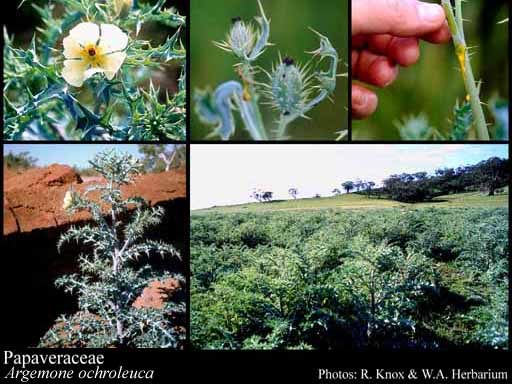- Reference
- Gen.Pl. [Jussieu] 235 (1789)
- Name Status
- Current

Scientific Description
Common name. Poppy Family.
Habit and leaf form. Herbs (mostly), or trees to shrubs (a few shrubs or small treelets); laticiferous, or with coloured juice (usually, the juice milky, yellow, or red), or non-laticiferous and without coloured juice (e.g. Eschscholtzia, Platystemon with watery juice). Annual, or perennial; plants with neither basal nor terminal concentrations of leaves. The treelets pachycaul. Mesophytic. Leaves alternate (usually, though the floral leaves are sometimes opposite or whorled), or whorled (ostensibly, in Platystemon); spiral; petiolate to sessile; non-sheathing; simple. Leaf blades dissected (usually), or entire; usually pinnatifid (lobed or dissected), or much-divided (e.g. bipinnatisect); pinnately veined; cross-venulate. Leaves without stipules; without a persistent basal meristem. Leaf anatomy. Hydathodes present (occasionally), or absent. Stem anatomy. Nodes unilacunar, or tri-lacunar. Secondary thickening absent (commonly), or developing from a conventional cambial ring.
Reproductive type, pollination. Fertile flowers hermaphrodite. Unisexual flowers absent. Plants hermaphrodite. Entomophilous.
Inflorescence and flower features. Flowers solitary (mostly), or aggregated in ‘inflorescences’; in cymes and in racemes. The terminal inflorescence unit cymose, or racemose. Inflorescences terminal; racemes or dichasia. Flowers medium-sized, or large; operculate (calyptrate), or not operculate; odourless; regular, or somewhat irregular. The floral asymmetry involving the perianth (when manifest). Flowers cyclic; tetracyclic to pentacyclic to polycyclic. Floral receptacle developing an androphore, or developing a gynophore, or with neither androphore nor gynophore. Free hypanthium absent (usually), or present (Platystemon). Hypogynous disk absent. Perianth with distinct calyx and corolla (usually), or sepaline (the corolla lacking in Macleaya); 6(–10); 1 -whorled, or 3 -whorled, or 4 -whorled; anisomerous (calyx whorl reduced relative to corolla whorls). Calyx 2(–4); 1 -whorled; polysepalous, or gamosepalous (sometimes basally connate, sometimes coherent into an operculum); calyptrate, or not calyptrate; imbricate; unequal but not bilabiate, or regular (usually rather asymmetrical); not persistent (caducous). Corolla 4, or 6, or 8, or 12, or 16; 2 -whorled (often 2+2 or 3+3), or 3 -whorled; polypetalous; imbricate and crumpled in bud; regular; yellow, or orange, or red, or pink, or blue; not spurred. Androecium 4–6 (Meconella), or 16–200 (usually ‘many’). Androecial sequence determinable, or not determinable. Androecial members usually maturing centripetally; free of the perianth; free of one another; 3–15 -whorled (generally indefinite in 2- or 3-merous, regularly alternating whorls). Androecium exclusively of fertile stamens. Stamens 4–6 (rarely), or 16–60; isomerous with the perianth (rarely), or diplostemonous to polystemonous. Anthers basifixed; non-versatile; dehiscing via longitudinal slits; tetrasporangiate. Gynoecium 2(–100) carpelled (to ‘many’). The pistil 1 celled, or 2–20 celled. Carpels isomerous with the perianth, or increased in number relative to the perianth. Gynoecium syncarpous; semicarpous (Platystemon), or eu-syncarpous (the stigmas often connate to form a discoid roof on the ovary); superior. Ovary unilocular, or plurilocular; 1 locular, or 2–20 locular (by intrusion of the placentas). Locules secondarily divided by ‘false septa’, or without ‘false septa’. Gynoecium when G2, transverse; non-stylate, or stylate. Stigmas as many as the placentas; dorsal to the carpels, or commissural, or dorsal to the carpels and commissural; often combined into a peltate structure; dry type; papillate; Group II type. Placentation when unilocular parietal (usually), or basal (Bocconia); when plurilocular, axile. Ovules in the single cavity when unilocular 1 (Bocconia), or 2–100 (usually ‘many’); when plurilocular, 2–50 per locule (few to ‘many’); horizontal, or ascending; with superior or lateral raphe; arillate, or non-arillate; anatropous, or campylotropous, or amphitropous.
Fruit and seed features. Fruit non-fleshy; more or less an aggregate (Platystemon), or not an aggregate; dehiscent (usually), or indehiscent (rarely), or a schizocarp (Platystemon); a capsule (usually), or a silicula, or a siliqua, or a nut (rarely). Capsules poricidal, or septicidal, or valvular. Seeds copiously endospermic. Endosperm oily. Embryo rudimentary at the time of seed release (sometimes), or weakly differentiated. Cotyledons 2. Embryo achlorophyllous (7/8). Seedling. Germination phanerocotylar, or cryptocotylar.
Physiology, biochemistry. Aluminium accumulation not found. Photosynthetic pathway: C3.
Geography, cytology, number of species. World distribution: mainly North temperate, but also in Iceland, Central America and West Indies, South Africa and Eastern Australia. X = (5-)6, 7, 8, 11, 19. 200 species.
Economic uses, etc. Unripe capsules of Papaver somniferum supply commercial opium, and numerous species from Papaver, Meconopsis, Argemone, etc. are cultivated as ornamentals.
Keys
Western Australian Genera and Families of Flowering Plants — an interactive key
T.D. Macfarlane, L. Watson, N.G. Marchant